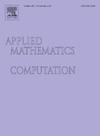Evolution of cooperation in spatial public goods games with migration and interactive diversity
IF 3.4
2区 数学
Q1 MATHEMATICS, APPLIED
引用次数: 0
Abstract
Evolutionary games on networks often assume that individuals do not move and adopt a uniform strategy toward all neighbors. In reality, however, individuals can migrate to seek more favorable conditions and may act differently depending on whom they interact with. Here, we fill this gap by extending the spatial public goods game on a two-dimensional lattice to include both migration and node-dynamics-based interactive diversity. Through systematic Monte-Carlo simulations, we demonstrate a clear division of labor: at low to moderate densities, mobility carves “escape corridors” that protect cooperators, whereas at high densities, interactive diversity spawns “imperfect” cooperative clusters able to endure strong social dilemmas. Most importantly, the combination of these two mechanisms substantially lowers the threshold for cooperation, enabling the system to sustain cooperation even under low-density and strong-dilemma conditions where previous models predict the collapse of cooperation. This complementary effect shows that migration seeds clusters while partner-specific reciprocity stabilizes them, creating a robust path to cooperation that neither mechanism can achieve alone. The result suggests a practical design rule: encourage limited mobility in sparse populations and foster interactive diversity in crowded ones to maximize prosocial behavior in complex adaptive systems.
迁移与互动多样性下的空间公共物品博弈合作演化
网络上的进化博弈通常假设个体不移动,并对所有邻居采取统一的策略。然而,在现实中,个体可以迁移以寻求更有利的条件,并可能根据他们与谁互动而采取不同的行动。在这里,我们通过在二维晶格上扩展空间公共物品博弈来填补这一空白,以包括迁移和基于节点动态的互动多样性。通过系统的蒙特卡罗模拟,我们展示了一种明确的劳动分工:在低到中等密度下,流动性划出了保护合作者的“逃生走廊”,而在高密度下,互动多样性产生了能够承受强烈社会困境的“不完美”合作集群。最重要的是,这两种机制的结合大大降低了合作的门槛,使系统即使在低密度和强困境条件下也能维持合作,而以前的模型预测合作会崩溃。这种互补效应表明,移民种子会聚集在一起,而特定于合作伙伴的互惠则会使它们稳定下来,从而创造出一条两种机制都无法单独实现的强健的合作之路。结果表明了一个实用的设计规则:在稀疏的人群中鼓励有限的流动性,在拥挤的人群中促进互动多样性,以在复杂的适应系统中最大化亲社会行为。
本文章由计算机程序翻译,如有差异,请以英文原文为准。
求助全文
约1分钟内获得全文
求助全文
来源期刊
CiteScore
7.90
自引率
10.00%
发文量
755
审稿时长
36 days
期刊介绍:
Applied Mathematics and Computation addresses work at the interface between applied mathematics, numerical computation, and applications of systems – oriented ideas to the physical, biological, social, and behavioral sciences, and emphasizes papers of a computational nature focusing on new algorithms, their analysis and numerical results.
In addition to presenting research papers, Applied Mathematics and Computation publishes review articles and single–topics issues.

 求助内容:
求助内容: 应助结果提醒方式:
应助结果提醒方式:


